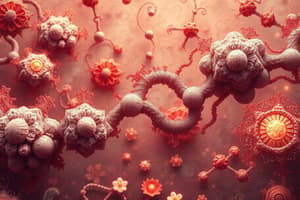Podcast
Questions and Answers
How do enzymes accelerate chemical reactions within biological systems?
How do enzymes accelerate chemical reactions within biological systems?
- By lowering the activation energy required for the reaction. (correct)
- By raising the activation energy required for the reaction.
- By increasing the equilibrium constant of the reaction.
- By altering the overall change in free energy of the reaction.
Which statement accurately describes the 'induced-fit' model of enzyme-substrate interaction?
Which statement accurately describes the 'induced-fit' model of enzyme-substrate interaction?
- The substrate induces a permanent change in the enzyme's structure.
- The enzyme's active site changes shape to better accommodate the substrate. (correct)
- The substrate perfectly matches the rigid active site of the enzyme.
- The enzyme remains unchanged during substrate binding.
What is the role of a cofactor in enzyme catalysis?
What is the role of a cofactor in enzyme catalysis?
- To change the equilibrium of the reaction.
- To protect the enzyme from denaturation.
- To provide additional surface area for substrates to bind.
- To assist in substrate binding and/or catalysis. (correct)
How does increasing the substrate concentration affect enzyme activity in a scenario where the enzyme concentration remains constant?
How does increasing the substrate concentration affect enzyme activity in a scenario where the enzyme concentration remains constant?
In competitive inhibition, how does an inhibitor affect the Michaelis constant (Km) and the maximum reaction rate (Vmax) of an enzyme?
In competitive inhibition, how does an inhibitor affect the Michaelis constant (Km) and the maximum reaction rate (Vmax) of an enzyme?
What distinguishes non-competitive inhibition from competitive inhibition?
What distinguishes non-competitive inhibition from competitive inhibition?
Which class of enzymes catalyzes the transfer of functional groups from one molecule to another?
Which class of enzymes catalyzes the transfer of functional groups from one molecule to another?
How does feedback inhibition regulate metabolic pathways?
How does feedback inhibition regulate metabolic pathways?
What is the significance of the Michaelis constant (Km) in enzyme kinetics?
What is the significance of the Michaelis constant (Km) in enzyme kinetics?
Which type of enzyme inhibition involves the inhibitor binding only to the enzyme-substrate complex?
Which type of enzyme inhibition involves the inhibitor binding only to the enzyme-substrate complex?
What is the function of oxidoreductase enzymes?
What is the function of oxidoreductase enzymes?
In enzyme regulation, what is meant by 'covalent modification'?
In enzyme regulation, what is meant by 'covalent modification'?
What is the role of enzymes in the detergent industry?
What is the role of enzymes in the detergent industry?
How do lyases catalyze reactions?
How do lyases catalyze reactions?
How does allosteric regulation affect enzyme activity?
How does allosteric regulation affect enzyme activity?
What is the function of ligase enzymes?
What is the function of ligase enzymes?
Why is enzyme specificity important in biological systems?
Why is enzyme specificity important in biological systems?
Which of the following is an example of therapeutic enzymes being used in medicine?
Which of the following is an example of therapeutic enzymes being used in medicine?
How does pH affect enzyme activity?
How does pH affect enzyme activity?
What is the term for the protein part of an enzyme without its cofactor?
What is the term for the protein part of an enzyme without its cofactor?
Flashcards
Enzymes
Enzymes
Biological catalysts, usually proteins (or ribozymes), that accelerate chemical reactions in living organisms.
Active Site
Active Site
The specific region on an enzyme where the substrate binds and catalysis occurs. Its shape and chemical properties are complementary to the substrate.
Cofactors and Coenzymes
Cofactors and Coenzymes
Inorganic ions or organic molecules required by some enzymes to function properly.
Apoenzyme
Apoenzyme
Signup and view all the flashcards
Holoenzyme
Holoenzyme
Signup and view all the flashcards
Activation Energy
Activation Energy
Signup and view all the flashcards
Enzyme Specificity
Enzyme Specificity
Signup and view all the flashcards
Lock-and-Key Model
Lock-and-Key Model
Signup and view all the flashcards
Induced-Fit Model
Induced-Fit Model
Signup and view all the flashcards
Absolute Specificity
Absolute Specificity
Signup and view all the flashcards
Relative Specificity
Relative Specificity
Signup and view all the flashcards
Stereospecificity
Stereospecificity
Signup and view all the flashcards
Vmax
Vmax
Signup and view all the flashcards
Michaelis Constant (Km)
Michaelis Constant (Km)
Signup and view all the flashcards
Enzyme Inhibitors
Enzyme Inhibitors
Signup and view all the flashcards
Competitive Inhibition
Competitive Inhibition
Signup and view all the flashcards
Non-Competitive Inhibition
Non-Competitive Inhibition
Signup and view all the flashcards
Uncompetitive Inhibition
Uncompetitive Inhibition
Signup and view all the flashcards
Feedback Inhibition
Feedback Inhibition
Signup and view all the flashcards
Oxidoreductases
Oxidoreductases
Signup and view all the flashcards
Study Notes
- Enzymes are biological catalysts that speed up chemical reactions in living organisms.
- They are typically proteins, although some catalytic RNA molecules (ribozymes) exist.
- Enzymes are highly specific, catalyzing only certain reactions or a set of closely related reactions.
- They are essential for various biological processes, including metabolism, digestion, and DNA replication.
Enzyme Structure
- Enzymes have a complex three-dimensional structure.
- The active site is a specific region on the enzyme where the substrate binds and catalysis occurs.
- The active site's shape and chemical properties are complementary to the substrate.
- Some enzymes require cofactors (inorganic ions) or coenzymes (organic molecules) to function.
- Apoenzyme refers to the protein part of an enzyme without its cofactor.
- Holoenzyme refers to the complete, catalytically active enzyme with its cofactor.
Enzyme Function
- Enzymes accelerate reactions by lowering the activation energy.
- They do not change the equilibrium of a reaction; they only affect the rate.
- Enzymes form temporary complexes with their substrates.
- The enzyme-substrate complex facilitates the reaction.
- After the reaction, the products are released, and the enzyme is free to catalyze another reaction.
Enzyme Specificity
- Enzyme specificity refers to the ability of an enzyme to catalyze a single reaction or a set of closely related reactions.
- Lock-and-key model: The substrate fits perfectly into the active site.
- Induced-fit model: The enzyme's active site changes shape upon substrate binding to achieve a better fit.
- Enzymes exhibit different types of specificity:
- Absolute specificity: Catalyzes only one specific reaction.
- Relative specificity: Catalyzes reactions involving similar molecules.
- Stereospecificity: Distinguishes between stereoisomers.
Factors Affecting Enzyme Activity
- Temperature:
- Enzyme activity increases with temperature up to an optimal point.
- High temperatures can denature the enzyme, causing loss of activity.
- pH:
- Enzymes have an optimal pH range.
- pH changes can affect the enzyme's structure and active site.
- Substrate concentration:
- Enzyme activity increases with substrate concentration up to a maximum rate (Vmax).
- Vmax is the maximum rate of reaction when the enzyme is saturated with substrate.
- The Michaelis constant (Km) is the substrate concentration at which the reaction rate is half of Vmax; it indicates the affinity of the enzyme for the substrate.
- Enzyme concentration:
- Enzyme activity is directly proportional to enzyme concentration (if substrate is in excess).
- Inhibitors:
- Substances that reduce enzyme activity.
Enzyme Inhibition
- Competitive inhibition:
- The inhibitor binds to the active site, preventing substrate binding.
- It increases Km but does not affect Vmax.
- The effect can be overcome by increasing substrate concentration.
- Non-competitive inhibition:
- The inhibitor binds to a site other than the active site, altering the enzyme's shape and reducing its activity.
- It decreases Vmax but does not affect Km.
- Increasing substrate concentration does not overcome the effect.
- Uncompetitive inhibition:
- The inhibitor binds only to the enzyme-substrate complex.
- It decreases both Km and Vmax.
- Irreversible inhibition:
- The inhibitor binds covalently to the enzyme, permanently inactivating it.
- These inhibitors are often toxic.
- Allosteric regulation:
- The binding of a molecule to a site other than the active site affects enzyme activity.
- Allosteric activators increase enzyme activity.
- Allosteric inhibitors decrease enzyme activity.
- Feedback inhibition:
- The end product of a metabolic pathway inhibits an enzyme earlier in the pathway.
- This helps regulate the production of the end product.
Enzyme Classification
- Enzymes are classified into six main classes based on the type of reaction they catalyze:
- Oxidoreductases: Catalyze oxidation-reduction reactions.
- Transferases: Catalyze the transfer of functional groups.
- Hydrolases: Catalyze hydrolysis reactions (addition of water).
- Lyases: Catalyze the breaking of chemical bonds by means other than hydrolysis or oxidation.
- Isomerases: Catalyze the rearrangement of atoms within a molecule.
- Ligases: Catalyze the joining of two molecules, often coupled with ATP hydrolysis.
- Each enzyme is assigned a unique Enzyme Commission (EC) number.
- The EC number consists of four numbers separated by periods, representing the class, subclass, sub-subclass, and serial number.
Enzyme Regulation
- Enzyme activity can be regulated by several mechanisms:
- Genetic control: Regulation of enzyme synthesis (transcription and translation).
- Covalent modification: Addition or removal of chemical groups (e.g., phosphorylation).
- Proteolytic cleavage: Activation of an enzyme by cleaving a proenzyme or zymogen.
- Allosteric regulation: Binding of molecules to sites other than the active site.
- Compartmentalization: Localization of enzymes in specific cellular compartments.
Enzymes in Medicine and Industry
- Enzymes are used in various medical applications:
- Diagnostic enzymes: Used to detect diseases by measuring enzyme levels in body fluids.
- Therapeutic enzymes: Used to treat diseases by replacing deficient enzymes or degrading harmful substances.
- Enzymes find wide applications in industry:
- Food industry: Used in baking, brewing, and cheese production.
- Textile industry: Used for bleaching and desizing fabrics.
- Detergent industry: Used to remove stains.
- Pharmaceutical industry: Used in drug synthesis and analysis.
- Paper industry: Used for pulp bleaching.
Summary of Key Concepts
- Enzymes are biological catalysts that speed up chemical reactions.
- They have specific active sites that bind substrates.
- Factors like temperature, pH, and substrate concentration affect enzyme activity.
- Enzyme inhibitors can reduce enzyme activity through various mechanisms.
- Enzymes are classified into six main classes based on their function.
- Enzyme regulation involves genetic control, covalent modification, and allosteric regulation.
- Enzymes have diverse applications in medicine and industry.
Studying That Suits You
Use AI to generate personalized quizzes and flashcards to suit your learning preferences.




